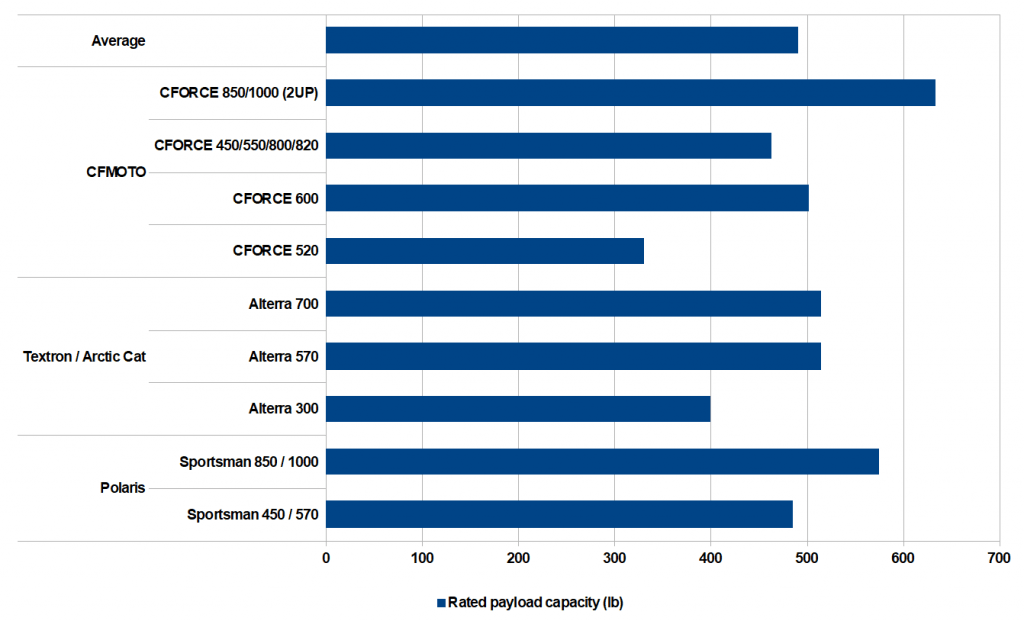Knowing how much weight your ATV can carry is essential for safe riding. Whether you plan on hauling some heavy cargo to a remote hunting cabin or loading up on gear for an ATV camping trip, you need to ensure you’re not adding more weight than the ATV can handle.
There are limits to how much weight the cargo racks can hold. There are limits to the rider’s weight, even though these numbers are usually not provided in the user manual.
So, how much weight can an ATV carry? Adult-size ATVs are designed to bring about 250lb of cargo. Typically you should place about 1/3rd of the weight on the front cargo rack and the remaining 2/3rd on the rear rack. The total payload capacity of an ATV ranges from 400 lb to 550 lb, with an average of about 490 lb.
Each fall, I use my ATV to carry hunting equipment and supplies to the cabin. The combined weight of all the gear and a well-fed rider quickly adds up.
I turned to the user manual to find the ratings for my specific bike, but the numbers they provide are not always self-explanatory.
To find the limit on your ATV, you must first understand the difference between the manufacturer’s various weight ratings. There are two main ratings you should look for:
- Payload capacity
- Front and rear rack load capacity
Related: How Much Can ATVs Tow – A Closer Look at Towing Capacity
Payload Capacity – The Total Weight an ATV Can Carry
The total amount of weight a specific ATV safely may carry should be listed in its user manual. There it is described as the bike’s “payload capacity.”
Note that not all manufacturers provide you with this number. That does not mean you can add as much weight as you want.
Payload capacity on an ATV refers to the total weight that the vehicle can safely carry. This includes the weight of the rider, any passengers, as well as any additional items such as equipment, supplies, or cargo stored on the vehicle.
The manufacturer determines the payload capacity; exceeding it can compromise the ATV’s performance, safety, and longevity.
The weight of the ATV itself, or fluids like gas and oil, is not included in the payload term and is usually referred to as the bike’s curb weight, dry weight, or wet weight, depending on whether they include the weight of the fluids.
So does this mean that the driver can be of any weight or that you can add any amount of cargo as long as the combined weight is below the rated payload capacity?
Well no. There are other limiting factors you need to consider — more on this further down.
What Is the Average ATV Payload Capacity?
If you’re looking for a general estimate of how much weight an ATV can carry or your particular make of ATV does not provide you with an exact payload capacity rating, I’ve collected some data that may give you a good idea of what to expect.
Please note that the specs provided only are meant as a general reference. Local laws and regulations in different countries and regions may result in different ratings, even on the same make and model of ATV.
About half of the major ATV brands do provide a payload capacity rating.
I’ve included all of the ratings available in the diagram below. Also, I used the available data to calculate an average.
If your ATV is not on the list, it means your brand currently provides this data. Comparing your bike with bikes of the same type and size should give you a general idea but no definite answer.
Factors such as frame design, suspension setup, and choice of materials may result in different results for two bikes that may look the same at first glance.
From the table, we can make a few interesting observations:
- The average total payload capacity is 491 lb (223 kg).
- A bigger bike usually means a higher payload capacity.
- Utility and recreational ATVs can carry significantly more weight than a dedicated sport or racing model.
- 2-up models can generally carry more weight, as they are set up with the firmest suspension to account for two passengers.
How Much Cargo Weight Can an ATV Carry?
Most ATVs have a front and rear cargo rack for carrying your gear. Racing models usually only have a rear rack, and some have no racks.
In addition to the bike’s total payload capacity, most ATV manufacturers will tell you how much weight you can put on each cargo rack. Most provide an individual rating for the two racks, while others only tell you the total amount for the front and rear racks combined.
Note that the value of the cargo rack rating will be included in the total payload capacity rating.
You can not add the rack capacity on top of the payload capacity. Doing so will certainly add more weight to the bike than it is designed to handle.
Once again, I have collected the data to compare the various brands easily. All of the bikes the data is collected from are 2019 or 2020 models:
The front rack generally holds about half of what the rear racks will hold. You must always distribute your cargo as ideally as possible to maintain the relative weight difference between the front and rear.
If you put all the weight on the front rack, the ATV becomes front-heavy and hard to steer. It will have a higher risk of flipping forward when riding downhill.
The same applies when putting too much weight on the rear rack.
Flipping backward when riding up a steep hill is a widespread cause of ATV accidents. Adding weight to the rear rack the risk of flipping increases significantly.
Is There a Rider Weight Limit for Adult-Size ATVs?
One of the cool things about ATVs is that they can help people with various mobility issues get out and enjoy nature more. People who feel their weight is holding them back get a chance to experience the outdoors in ways they otherwise couldn’t.
This raises the question of whether there is a limit to how much an ATV rider can weigh.
The manufacturers do not provide a “rider weight limit “rating, so we’re in many ways left guessing.
What if we take the rated payload capacity and subtract the rated rack capacity? In most cases, we are left with a relatively small number.
Let us use a Polaris 570 as an example. The rated payload capacity for this particular model is 485lb. After subtracting the front and rear cargo weight ratings, we are left with only 215lb (98kg).
Indeed, if you don’t bring any cargo, the bike should have no problems handling a much higher rider weight than this.
Generally, riders weighing up to 300lb (136kg) should operate most adult-size ATVs safely. Heavier riders are off choosing a bigger ATV for stability. But if you’re pushing 400 lb (181 kg), other factors than the ATV’s weight rating come into play.
Practical Limitations to ATV Rider Weight
In theory, An ATV is structurally capable of managing rider weights up to its rated payload capacity. But when it comes to ATV riding, theory, and practice are not always the same.
A rider of the same weight as the rated payload capacity of any ATV will likely struggle to operate the vehicle effectively and safely, particularly in rough terrain. Let us look at why.
A Higher Center of Gravity Leading to Tipping Issues
Firstly vehicle becomes top-heavy, making it more likely to tip. With a heavier rider, the center of gravity is typically higher than a lighter rider with some cargo on the cargo racks.
Rider Mobility: Fit-in Issues
Riding an ATV is not like riding a car; the rider needs to be able to move around on the vehicle freely to ride it properly. Shifting your body weight is essential to safe ATV riding in any riding application, even trail riding.
If your weight prevents you from moving freely while sitting on the bike, this may become a limiting factor.
A 300lb rider on a 400cc ATV will be snug. A larger ATV will provide more room for moving around and allow for better handling.
Insufficient Arm Strength
Another aspect to consider is that severely overweight riders may not have the necessary arm strength to hold on to the handlebars when cornering at higher speeds.
Any size rider will likely fall off an ATV if they lose their grip at a turn. But heavier riders have more weight they need to hold in place using the strength in their arms.
Youth ATVs Rider Weight Limit
Youth ATVs are small-size machines designed for kids of a specific age range. But are there any weight limits to how much the rider can weigh on these?
ATV manufacturers usually do not provide a rider weight limit for youth models.
Instead, they rate a recommended minimum age that the rider should match before riding a specific youth model.
When a child reaches the minimum recommended age for a given model, they are likely too big and too heavy for a model one size smaller.
But what if the child is overweight?
Let’s say a specific 10-year-old weighs the same as an average 14-year-old. This means he is almost too big size-wise for ATVs rated for 10-year-olds. But he is not yet mature enough to safely operate a model rated for 14-year-olds.
Related: This is how you choose the best ATV for a 10-year-old
Does Adding Too Much Weight Damage the ATV?
The ATV likely won’t break even if you add slightly more weight than recommended. Just don’t attempt any big jumps.
However, adding too much weight will have a severely adverse effect on the vehicle’s rideability.
It will become much harder to steer and more likely to tip over due to an elevated center of gravity (becoming top-heavy).
The shocks compress more than they should and will not have sufficient remaining travel to work correctly. Over time, the springs may lose some tension due to overload.
If you plan on hauling more weight than the bike is designed to handle, it is recommended that you divide your load into several smaller loads or use an ATV trailer that can carry significantly more weight for each shipment.
FAQ
What does ATV payload capacity mean?
ATV payload capacity refers to the maximum weight that an ATV can safely carry, including the rider’s weight and any cargo or accessories.
How can I find my ATV’s payload capacity?
Your ATV’s payload capacity should be listed in the user manual. If you don’t have it, contact the manufacturer or a professional for help.
Can exceeding my ATV’s payload capacity be dangerous?
Yes, exceeding the payload capacity of your ATV can negatively impact its handling and performance and could potentially cause accidents.
Wrapping Up
In conclusion, understanding the payload capacity of your ATV is essential for safe and efficient use. The weight limit varies depending on the model and the manufacturer. Always refer to your ATV’s manual for specific details and guidelines.
Remember, it’s not just about whether your ATV can carry a load but about how safely it can do so.



